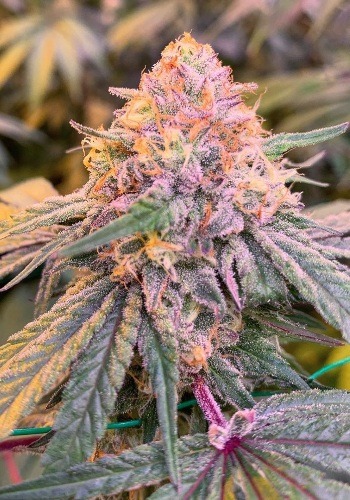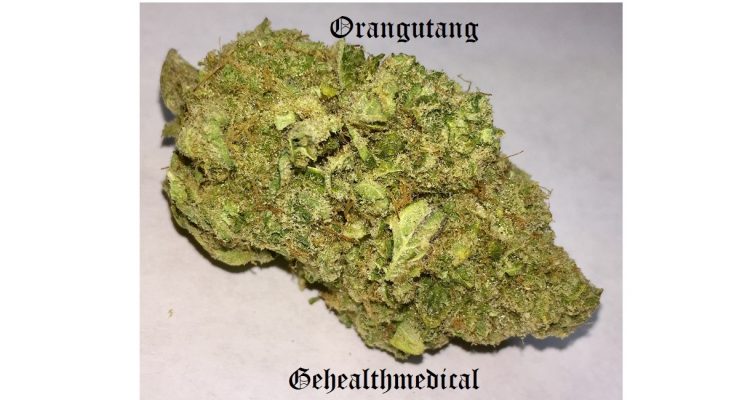Hybrid – 50% Sativa /50% Indica
THC: 17% – 21%
Orangutang, also known as “OranguTANG,” is an evenly balanced hybrid strain (50% indica/50% sativa) created through crossing the classic Orange Crush X Tangie X Citrus Sap strains. Famous for its super sour flavor and giddy full-bodied high, Orangutang is a favorite of hybrid lovers around the world. This bud has a lip-puckering sour orange and grapefruit flavor with a delicious punch of savory diesel to it, too. The aroma is very similar, with a sour orange overtone accented by deep spicy diesel and pungent gas. The Orangutang high hits you almost as soon as you exhale, smashing between the eyes with a mind-numbing tingle. You’ll feel euphoric with a lifted sense of mental weightlessness that soon creeps its way throughout the rest of your body, leaving you completely relaxed from head to toe. This is accompanied by a boost of sociability, which lends itself well to any conversations that you may be having with those around you. With these effects and its high 17-21% average THC level, Orangutang is said to be perfect for treating chronic pain, mood swings, depression, appetite loss or nausea and headaches or migraines. This bud has fluffy rounded forest green nugs with lots of thin dark amber hairs and a coating of tiny bright amber crystal trichomes.

You can find out about Pai Gow Marijuana Strain here!
The budtenders can be a lot of mind. Any request for a new way of the product will likely make one to decomple the last fresh skunky batch of Blue sleep or Purple Urkle or Master Kush for your nasal delight. The commonly proffer stuff smells very new indeed, but a recent trip to a dispensary in a sketchy part of the city attracted an unusually conspiratorial answer to a question. The counter-guy rodey and produced a giant red and orange hunk of the aforementioned dank from outside the indica section. Doubtful, I buy it anyway, do some due-diligence research and find this tension is as new as having never been reviewed or even mentioned. Statistics are not existent. The strains ‘ names indicate kinship with other strains of name comanchers like Grape Ape or the most popular Gorilla Glue No. 4, or could just mean that naming your weed after primates is going a thing this year. In any case, the subjective effects of this mono-monikered mould were pleasantly undicalike. Trippy imaginations, suddenly the emphasis and the long-running head were three of the most notorious effects, and the reviewers can always measure the effectiveness of good indica by how slow down the speed of writing is turned. Up some fractions of point for the persistence of pure buzz dog. Wrap: it May well be the next rung on the evolutionary weed ladder.
| THC | 15%-24% |
| Yield | 1.45 oz/ft2 |
| Type | Sativa |
| Flowering Period | 50-70 days |
| Climate | Mediterranean |
| Growing Difficulty | Moderate |
| Height | Medium |
| Flavors | Citrus, Spicy –haze, earthy, black pepper |
What are the flavors and effects of Orangutan Strain?
Users can immediately be filled with intense citrus flavors with a hint of spicy-haze, black pepper, and earthy. Due to its sour undertones, it creates a way to a hasty physical reaction as well as a euphoric headband feeling that makes them giggly.

You can find out about Mega Jackpot Marijuana Strain here!
What are the Medical Benefits of Orangutan Strain?
Orangutan strain is said to be ideal in treating conditions such as chronic stress; it relaxes the mind and lesson negative thoughts while keeps your power-up. It also relieves a variety of types of aches and pains. Moreover, it also has anti-inflammatory properties that lessen the redness and swelling
Negative Side effects of Orangutan Strain?
Many people love the positive effects of this weed, but one of the problems or adverse side effects is that its high does not last that long.
How to grow Orangutan Strain?
This strain is easy to cultivate. This strain likes warm and dry outdoor weather so that it could thrive. The flowering period of this plant is usually best left extended to gain more yield. By temporarily closing the strain will aid to stay warm and protect it from possible snowy weather.
Genetics
Orange Crush X Tangie X Citrus Sap
Orange Crush
Orange Crush is known for its dank earthy scent and citrus flavor. This Sativa-dominant strain that was devised by the minds at BC Growers Association produces a powerfully soaring cerebral high that wraps the mind in a blanket of euphoria. For experienced users, the effects are generally described as positive, uplifting energy that spurs creativity.
The orange-like taste of this strain’s smoke may also, unfortunately, bring about cotton mouth and dry eyes for most novice users. Some who use this strain may also feel light-headed and report feeling “the spins” – an unwanted effect that leaves the user feeling as if the room is spinning. The usual feeling of paranoia that exists with many Sativa strains may also occur when using higher doses.
Though some find the strain makes them feel more anxious, many more instead find relief from chronic stress, anxiety and nervousness typically brought on by depression-related disorders or PTSD. Orange Crush’s ability to increase the production of dopamine, the chemical that causes one to feel happy, is used to help fight off the effects of chronic depression.
Tangie
Tangie is Sativa-dominant cannabis strain – 70 percent Sativa and 30 percent Indica. This strain pays tribute to Tangerine Dream, a popular strain back in the day (1995). It is a cross between a Skunk strain and California Orange. The THC level is 19 to 22 percent and the CBD level is 0.09 percent. This strain wins over and over again at the Cannabis Cups – one time winning 10 prizes in 10 months.
With its citrus heritage, Tangie has a refreshing sweet aroma like tangerines (except for some Skunk scent and taste due to its lineage,) distinguishing it from the other citrusy or fruity strains, mostly lemon or grape. The light green buds are small and compact, have orange hairs, and are covered by frosty trichomes.
Heavily influenced by Sativa, Tangie gives recreational users the uplifting effects they are looking for. Cerebral characteristics include euphoria, creativity, focus, and happiness. The THC level is above average making it more suitable for the intermediate or advanced user.
Citrus Sap
Citrus Sap is a sativa-dominant hybrid created as a joint venture between Crockett Family Farms, creators of Clementine, and the prolific DNA Genetics, who have given us flavorful strains like Lemon Skunk and Chocolope. Citrus Sap is a cross between powerful indica Gorilla Glue #4 and flavorful sativa Tangie. Despite its mostly sativa genetics, this strain tends to offer powerfully sedative effects. Besides leaving behind a lingering cloud of sweet, citrus funk, Citrus Sap is liable to leave you couch locked and daydreaming. Its THC content has been measured at between 17% and 24%.
Flowers of Citrus Sap tend to have a conical shape, tapering down from a broad base into a pointed tip. They range in size from small to medium and cling together in the dense, solid structure typically associated with indicas. The leaves are a pale shade of spring green and are threaded through with dark, rust-colored hairs (which are actually pistils, structures meant to catch pollen from fertilizing male plants). True to the “sap” in their name, flowers of Citrus Sap are covered in silvery resinous trichomes, giving them a frosty appearance.
Like parent strain Tangie, Citrus Sap has a predominantly citrus smell, redolent of oranges and tangerines. Underlying this sharp aroma is a sweetness that verges on sour, with a slightly rank, fermented edge. On closer inspection, these buds also carry the woodsy odor of pine. Meanwhile, grinding up or breaking open the flowers yields some slightly skunky notes. When burnt in a joint or a pipe, Tangie gives off a thick and lung-expanding smoke that may induce coughing or cause eyes to water. On the exhale, this bud’s flavors meld, as the smoke leaves behind the tastes of citrus-inflected pine sap.

